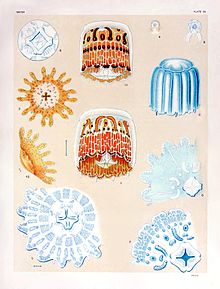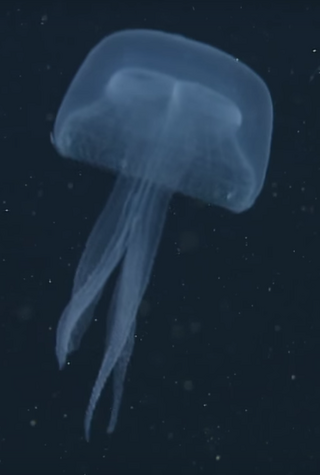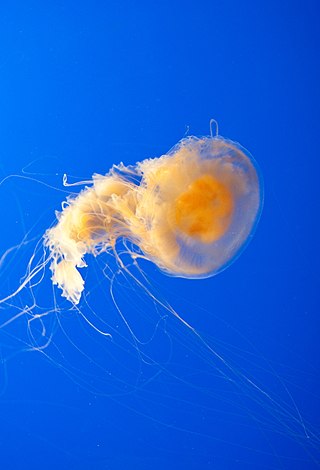| Linuchidae | |
|---|---|
 | |
| 1-10. Linuche unguiculata 11. Linuche aquila (top centre) | |
| Scientific classification | |
| Kingdom: | Animalia |
| Phylum: | Cnidaria |
| Class: | Scyphozoa |
| Order: | Coronatae |
| Family: | Linuchidae Haeckel, 1879 |
| Genera | |
| Linuchidae | |
|---|---|
 | |
| 1-10. Linuche unguiculata 11. Linuche aquila (top centre) | |
| Scientific classification | |
| Kingdom: | Animalia |
| Phylum: | Cnidaria |
| Class: | Scyphozoa |
| Order: | Coronatae |
| Family: | Linuchidae Haeckel, 1879 |
| Genera | |
The family additionally contains the accepted genus Linerges , according to the World Register of Marine Species, but no species are within it, all having been synonymized with species in Linuche. Additionally, the unassessed genus Liniscus is part of the family.

The Scyphozoa are an exclusively marine class of the phylum Cnidaria, referred to as the true jellyfish.

Stellamedusa is a genus of jellyfish. The genus is monotypic with a single species recognized, Stellamedusa ventana.

Rhizostomae or Rhizostomeae is an order of jellyfish. Species of this order have neither tentacles nor other structures at the bell's edges. Instead, they have eight highly branched oral arms, along which there are suctorial minimouth orifices. These oral arms become fused as they approach the central part of the jellyfish. The mouth of the animal is also subdivided into minute pores that are linked to coelenteron.

Cassiopea is a genus of true jellyfish and the only members of the family Cassiopeidae. They are found in warmer coastal regions around the world, including shallow mangrove swamps, mudflats, canals, and turtle grass flats in Florida, and the Caribbean and Micronesia. The medusa usually lives upside-down on the bottom, which has earned them the common name. These jellyfish partake in a symbiotic relationship with photosynthetic dinoflagellates and therefore, must lie upside-down in areas with sufficient light penetration to fuel their energy source. Where found, there may be numerous individuals with varying shades of white, blue, green and brown.

A salp or salpa is a barrel-shaped, planktonic tunicate in the family Salpidae. It moves by contracting, thereby pumping water through its gelatinous body, one of the most efficient examples of jet propulsion in the animal kingdom. The salp strains the pumped water through its internal feeding filters, feeding on phytoplankton.

Crown jellyfishes are the six families of true jellyfish that belong to the order Coronatae. They are distinguished from other jellyfish by the presence of a deep groove running around the umbrella, giving them the crown shape from which they take their name. Many of the species in the order inhabit deep sea environments.

Phacellophora camtschatica, commonly known as the fried egg jellyfish or egg-yolk jellyfish, is a very large jellyfish in the family Phacellophoridae. This species can be easily identified by the yellow coloration in the center of its body which closely resembles an egg yolk, hence how it got its common name. Some individuals can have a bell close to 60 cm (2 ft) in diameter, and most individuals have 16 clusters of up to a few dozen tentacles, each up to 6 m (20 ft) long. A smaller jellyfish, Cotylorhiza tuberculata, typically found in warmer water, particularly in the Mediterranean Sea, is also popularly called a fried egg jellyfish. Also, P. camtschatica is sometimes confused with the Lion's mane jellyfish.

Stomolophus is a genus of true jellyfish from the West Atlantic and Pacific. It is the only genus in the monotypic family Stomolophidae. Formerly, Nomura's jellyfish was also included in this genus, but has now been reclassified to the family Rhizostomatidae.

Malo is one a genus of box jellies in the family Carybdeida in the Phylum Cnidaria. It has four known species, three of which were described by the Australian marine biologist Lisa-Ann Gershwin. The genus was discovered in 2005. Many of the species are known for their paralytic and deadly affect. Many species in the Malo genus are very small and hard to capture and study. Many species of Malo have been captured on the Western and Eastern cost of Australia. Malo appear to be solidarity jellies.

Aurelia is a genus of scyphozoan jellyfish, commonly called moon jellies. There are currently 25 accepted species and many that are still not formally described.

Turritopsis is a genus of hydrozoans in the family Oceaniidae.

Cephea is a genus of true jellyfish in the family Cepheidae. They are found in the Indo-Pacific and eastern Atlantic oceans. They are sometimes called the crown jellyfish, but this can cause confusion with the closely related genus Netrostoma or the distantly related species in the order Coronatae. They are also sometimes called the cauliflower jellyfish because of the cauliflower-looking form on top of its bell.

Porpita is genus of hydrozoans in the family Porpitidae. It has two species recognized and is the type genus of its family.

Lipkea is a genus of stalked jellyfish. It is the only genus in the monotypic family Lipkeidae. Lipkea species lack tentacles at the end of their bell.

Coronamedusae is a subclass of jellyfish in the class Scyphozoa. It is the sister taxon of Discomedusae and contains about 50 named species, all included in the order Coronatae. Jellyfish in this subclass are either small medusae living in shallow marine environments, or large medusae living in the deep sea.

Linuche aquila is a species of cnidarian found in the tropical and subtropical Pacific Ocean. It is very small and is commonly known as a thimble jellyfish because of its size and shape. The larvae can cause bathers to develop an itchy red rash commonly known as seabather's eruption.
Linantha is a genus of crown jellyfish in the family Linuchidae. It is a monotypic genus and the only species is Linantha lunulata which was first described by the German biologist Ernst Haeckel in 1880. It is found in the tropical eastern Pacific Ocean in the vicinity of the Galápagos Islands.
Linuche is a genus of cnidarians belonging to the family Linuchidae.
Atolla vanhoeffeni is a species of true jellyfish in the family Atollidae.
Stephanoscyphistoma is a genus of crown jellyfish. Its taxonomic placement has been disputed, having been placed in Hydrozoa and Scyphozoa, and additionally having contained former members that were discovered to produce medusae belonging to the genera Atorella and Nausithoe.
![]() Data related to Linuchidae at Wikispecies
Data related to Linuchidae at Wikispecies